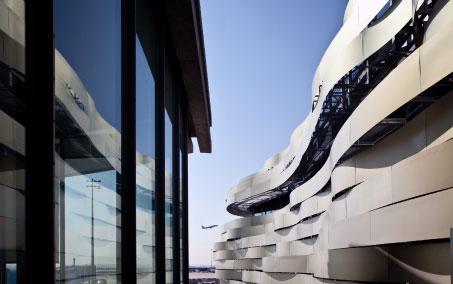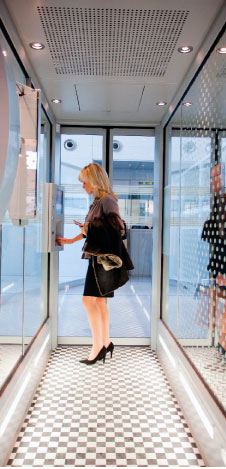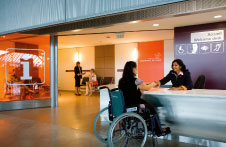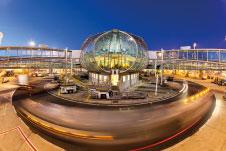
The 16,600sqm AC Junction at Paris-CDG was constructed to link the airport’s Terminals 2A and 2C for a standardised quality of services and comfort airport-wide. Photograph: Mikael Lafontan and Olivier Seignette
In 2012, Aéroports de Paris (AdP) embarked upon improvements across its portfolio. The operator is demonstrating that it is truly at the forefront of the industry, with renovations to its airports that will transform the passenger experience for every category of traveller. It is currently the midst of a major modernisation project at Paris-Orly. The six-year renovation was launched in October last year. It will result in the unification of its two terminals – Orly South and Orly West – to form a more efficient airport environment that will consist of a single terminal and three departure lounges with simplified access and passenger flow. The most emblematic feature of the airport’s €450 million transformation is the construction of a 80,000sqm link between the two existing terminals, to be completed in 2018, and alongside it the building of a new 20,000sqm departure lounge, which will open in 2015. Recently appointed Aéroports de Paris CEO Augustin De Romanet explained that the ambitious development project will generate more space in the terminal and greater comfort for airlines and passengers and, when completed, will create an additional 5,000 jobs at the airport.
Horizon 2018 initiative
The renovations at Paris-Orly are part of AdP’s exhaustive Horizon 2018 initiative for improvements to infrastructure and an enhanced passenger experience. The programme also implemented a significant investment to improve capacity at Charles de Gaulle, and the hub should not need to expand its capacity again for a decade, now having room for an additional 33 million passengers – an increase equivalent to the size of Paris-Orly.
Following the expansion, passenger traffic at Paris-CDG last year reached its highest yet, with a throughput of 61.6 million, and propelling passenger traffic across AdP to nearly 89 million. De Romanet explained that the majority of AdP’s airlines are not planning to increase their offering significantly for the summer schedule, and he is therefore expecting stable traffic numbers for 2013, though revenues should see slight growth. “Regardless of the vagaries of the economic cycle, I remain optimistic,” he said. “Medium and long-term growth for air travel is bound to continue, as the number of people across the world required to travel by air is constantly rising. An airport like Paris-Charles de Gaulle is perfectly sized to respond to this increased traffic, at least until the mid-2020s.”
De Romanet’s strategic priority is now focused on improving operational performance and service quality. He said: “In this respect, our efforts will endeavour to standardise the welcome reserved for passengers and the atmosphere found in the various terminals. We are therefore continuing with the renovation of the oldest terminals at Paris-Charles de Gaulle, notably Terminal 2B and the departure lounges in Terminal 1. I also want AdP to improve the overall satisfaction of arriving passengers, while striving for excellence with the service it provides for people with disabilities or reduced mobility. Passengers must have a positive, and wherever possible, unique experience in our terminals. This explains our innovative start to the year with the opening of a museum in Hall M of Terminal 2E, which is currently exhibiting works by the sculptor Auguste Rodin.”
Innovating for the passenger

AdP recently launched its ‘Parafe’ automated border control scheme. Developed in collaboration with the French Interior Ministry, the innovative process utilises biometric finger print checks and takes just seconds, giving passengers greater autonomy and helping them save time.
Indeed, Aéroports de Paris is implementing a multitude of initiatives to augment the passenger experience, including innovative technology designed to streamline the airport journey. At Paris-Orly, AdP introduced an entirely new area in the West Hall dedicated to self-service bag drop in December last year. With five automated bag drop points, its initial performance has been very successful, with up to 3,000 bags being self-processed every day, to enthusiastic passenger feedback. Its ‘Parafe’ automated border control scheme utilises biometric fingerprint recognition for check-in that takes just seconds, while the operator is setting an industry-leading example with ‘My Way Aéroports de Paris’, a geolocation and passenger guidance mobile app for Paris-CDG, which, according to de Romanet, is an airport world first in passenger wayfinding. The ‘My Airport’ application also provides passengers with real-time, personalised information on their flights.
“Furthermore, we are currently rolling out touch screen information terminals which use a bar code reader to scan boarding cards and provide passengers with all the information they require on their flight, the route to their boarding gate and the services available, in either video or map format with an indication of the time required,” added de Romanet.
Industry firsts

AdP’s next step is to become a global leader in services for Passengers with Reduced Mobility. On this point, de Romanet is unequivocal: “What do we owe our passengers with disabilities and reduced mobility? Service of the highest standard, with comfortable waiting areas and Aéroports de Paris staff fully trained in how to deal with every kind of disability.” Photograph: Mikael Lafontan and Olivier Seignette
De Romanet explained that innovation is fundamental to AdP’s core principles. In 2010 AdP created its ‘lab’ unit, solely dedicated to the research and experimentation of new services designed to improve the airport journey, and its Customer Service Academy also provides original ways of improving the passenger experience, giving everyone employed by AdP the chance to develop their ‘customer culture’ knowledge. “Our latest initiative was a forum, organised in partnership with Air France, entitled ‘Discovering and welcoming Indian customers’,” de Romanet explained. “Over four days, all stakeholders involved in greeting customers at the airport were able to discover the specific expectations of Indian customers, whose numbers are increasing in our terminals. We have also organised a forum focused on welcoming Chinese passengers. Since it began in April 2011, the Customer Service Academy has trained over 13,000 employees, 45% of which came from outside the company. It really is a great success.”
AdP has invested heavily in pursuing its strategy for made-to-measure passenger services. Its Chinese-language website provides visitors with practical information on getting to and from the Paris airports, some essential French vocabulary and key places to visit in Paris, and the information has since been made available in 10 languages. It has put in place several specially-tailored reception services for international passengers at both Paris-CDG and Paris-Orly.

In a record year for traffic, passenger numbers at AdP’s airports grew by +0.8% to 88.8 million, with throughput at Paris-CDG reaching an all-time high of 61.6 million. Photograph: Emile Luider, La Company
“Our full range of new services makes our passengers’ journey easier, right from their home country. The aim is to be attentive to each and every one of them. These services were first available to Chinese passengers, then for Russian and Japanese passengers this year,” de Romanet said. “Right from the baggage reclaim area, passengers are greeted with audio welcome messages, broadcast automatically depending on the origin of the flight, and hostesses are there to hand out maps of the airport and of Paris.”
AdP’s aim for this year is to become a global leader in services for Passengers with Reduced Mobility (PRMs). On this point, de Romanet is unequivocal: “What do we owe our passengers with disabilities and reduced mobility? Service of the highest standard, with comfortable waiting areas and Aéroports de Paris staff fully trained in how to deal with every kind of disability. I believe in extensive cooperation with the associations that work on behalf of people with disabilities, with airlines and companies that specialise in support services, together we have to move forward with these issues.”







